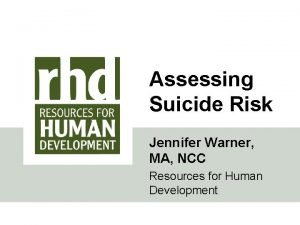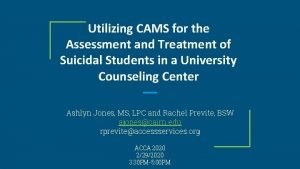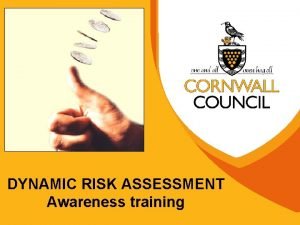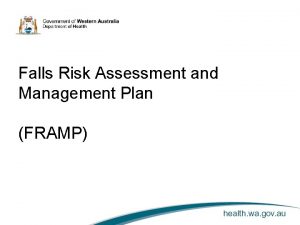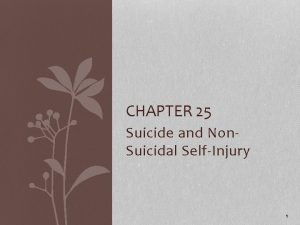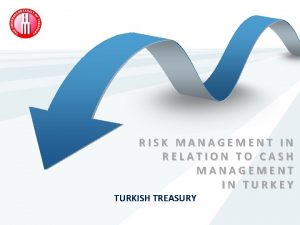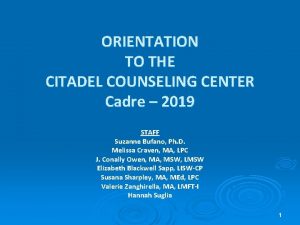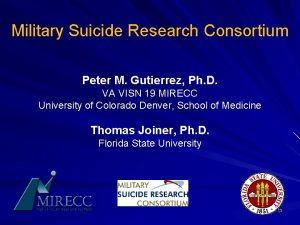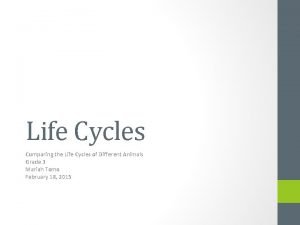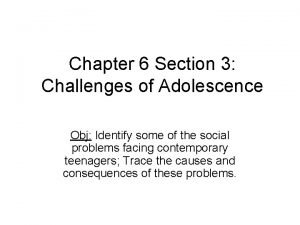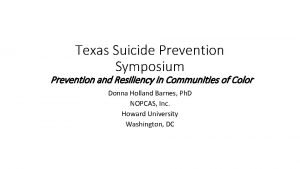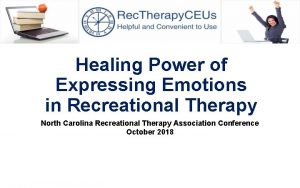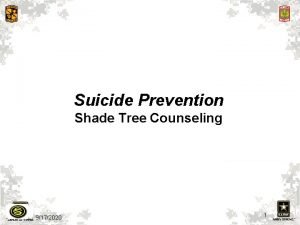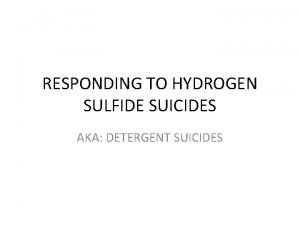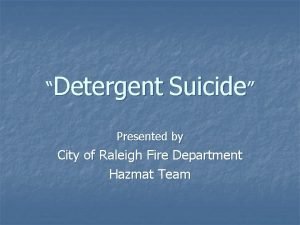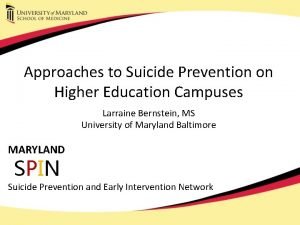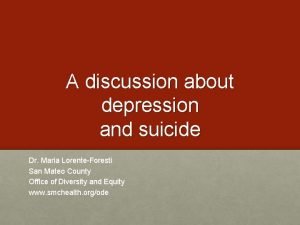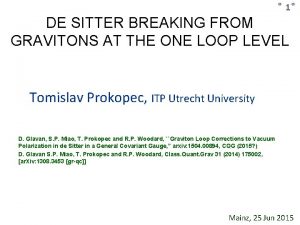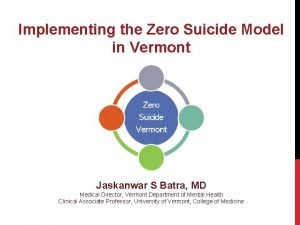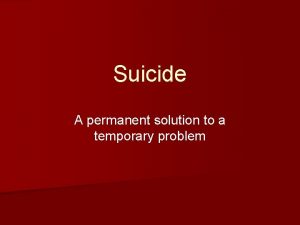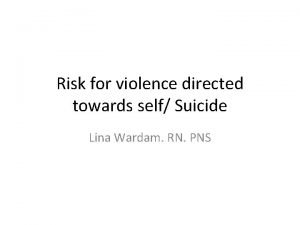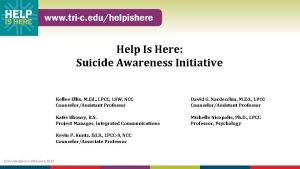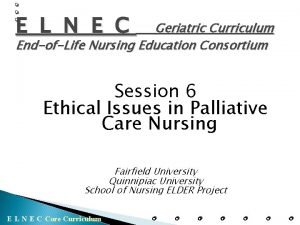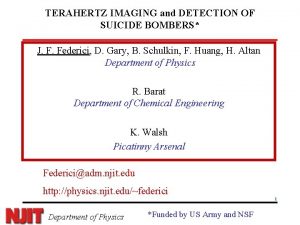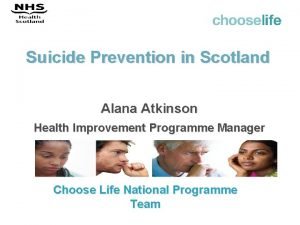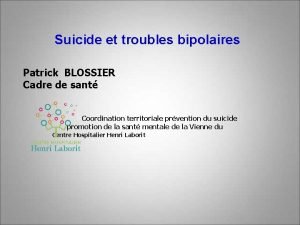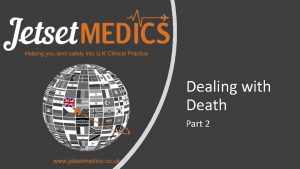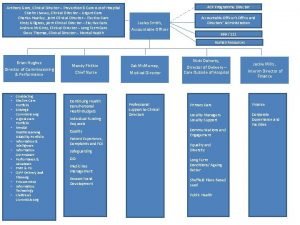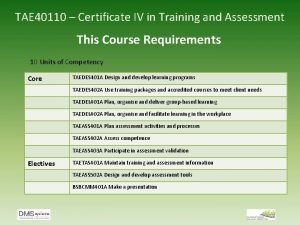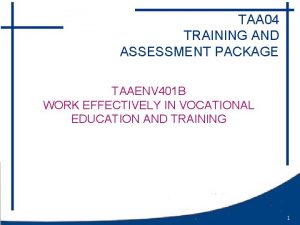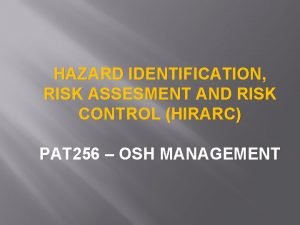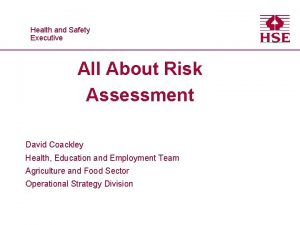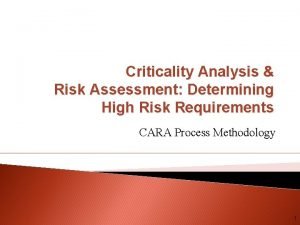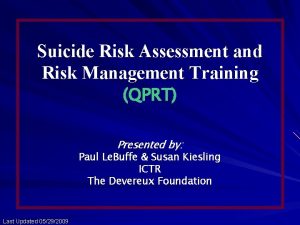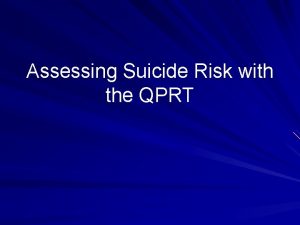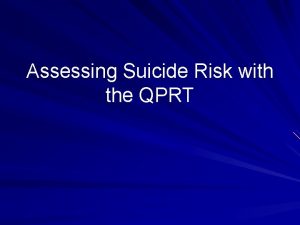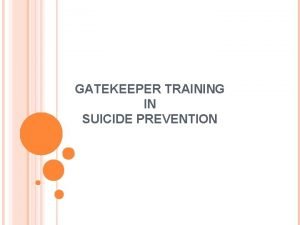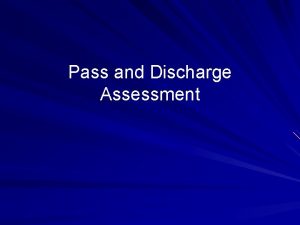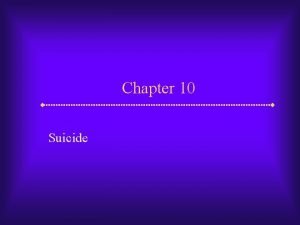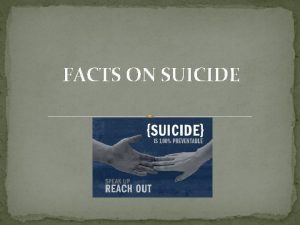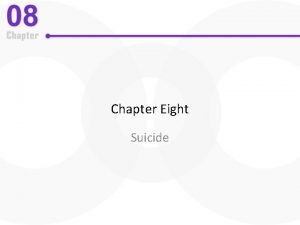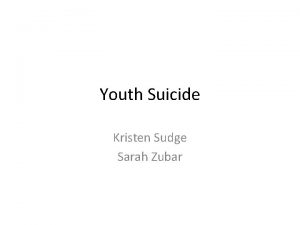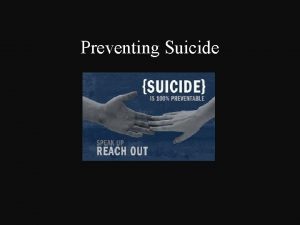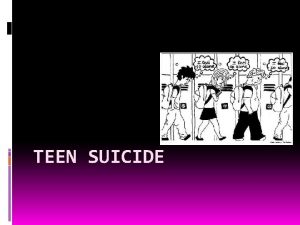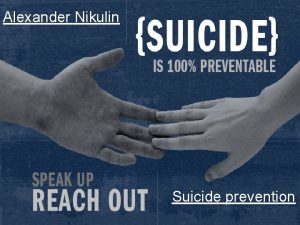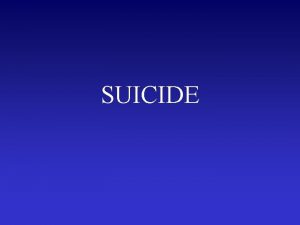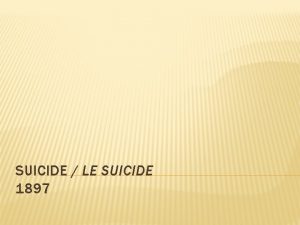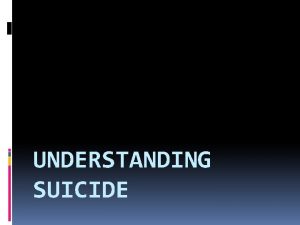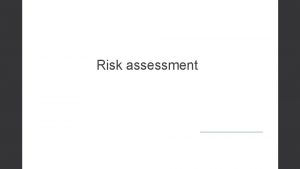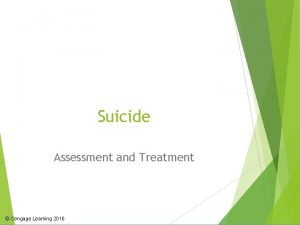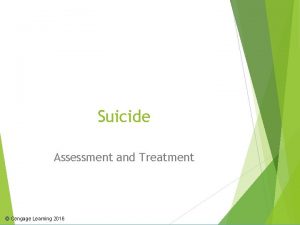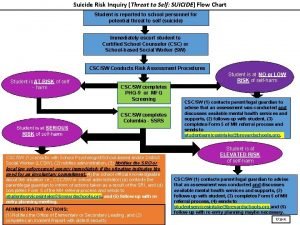Suicide Risk Assessment and Risk Management Training QPRT










































































- Slides: 74

Suicide Risk Assessment and Risk Management Training (QPRT) Presented by: Paul Le. Buffe & Susan Kiesling ICTR The Devereux Foundation Last Updated April 2009

QPRT Schedule 8: 30 - 8: 45 - 9: 00 – 10: 30 Introductions & Overview of the Day Devereux’s Suicide Risk Reduction Program The Magnitude of Suicide Problems in the United States Overview of Suicide Risk and Protective Factors 10: 30 - 10: 45 BREAK 10: 45 - 12: 00 Suicide and Malpractice 12: 00 - 12: 45 LUNCH 12: 45 - 1: 15 - 2: 15 Approaches to Suicide Risk Assessment Overview of the QPRT 2: 15 - 2: 30 BREAK 2: 30 - 3: 15 - 3: 35 QPRT Practice Exercise Re-Evaluation and Pass/Discharge MR/DD Guidelines Management of the Suicidal Client Final Discussion, Posttest, and Evaluation 3: 35 - 4: 00 - 4: 30

Devereux’s Suicide Risk Management Program Three Goals: 1. 2. 3. Reduce the incidence of suicide spectrum behavior among Devereux clients To protect Devereux and Devereux staff from unnecessary lawsuits To provide, as much as possible, peace of mind to Devereux staff should we have a client complete suicide

Devereux’s Suicide Risk Management Program Four Objectives: 1. 2. 3. Every Devereux staff completes a 60 -minute suicide awareness and prevention program (QPR) Every Devereux clinician completes a full-day suicide risk assessment program (QPRT) Every Devereux client is assessed for suicide risk at: 1. 2. 3. 4. Admission Midtreatment, or when there are significant changes in risk factors, protective factors or level of care. Discharge Every Devereux center has a suicide-specific crisis response plan.

Why? Suicidal ideation/behavior is the most common reason for psychiatric admissions. (Friedman, 1989) Approximately 17% of all suicides are completed in treatment. (Busch et al. , 1993: Litman, 1982) Why? There is a high incidence of suicide following hospitalization, particularly within the first three months. (Roy, 1986) Why? 1/3 of suicides occur in the hospital 1/3 of suicides occur on authorized pass 1/3 of suicides occur on unauthorized pass (Farberow, 1994: Litman, 1982)

JCAHO New Inpatient Care Standards As of January 2007, every JCAHO accredited behavioral health care organization must have a formal process in place for assessing and managing suicide risk. At Devereux, we were ahead of the curve. We have had these procedures in place for over seven years.

The Magnitude of the Suicide Problem in the United States


American Numbers: 2006 Data 33, 300 completed suicides in 2006 Rate: 11. 1 per 100, 000 89. 4 per day (equivalent of one commercial jet every other day) One person every 15. 8 minutes Suicide does not respect age, race, religion, social or economic status; it’s an equal opportunity mode of death.

Suicide is a leading cause of death Rank & Cause 1. Diseases of the heart 2. Malignant neoplasms 3. Cerebrovascular diseases 4. Chronic lower respiratory disease 5. Accidents 6. Diabetes mellitus 7. Alzheimer’s disease 8. Influenza & pneumonia 9. Nephritis, nephrosis 10. Septicemia 11. Suicide Number of deaths 631, 636 559, 888 137, 119 124, 583 121, 599 72, 449 72, 432 56, 326 45, 344 34, 234 33, 300 Ranking 11 th in the USA (CDC 2005 Data)

Suicide is the 11 th leading cause of death with 33, 300 deaths Homicide is the 15 th with 17, 357! Why don’t we hear more about suicide in the media? Source: AAS, 2006

Youth Suicide: CDC 2007 Data For youth ages 10 to 24: q Suicide is the 3 rd leading cause of death q There are 4600 lives lost each year q Each year, about 142, 000 receive medical care for self-inflicted injuries q 82% of the deaths were males and 18% were females, still females are more likely to report attempting suicide than boys

Youth Suicide: CDC 2007 Data A nationwide survey of youth in grades 9 -12 found that in the 12 months preceding the survey: q 15% of students reported seriously considering suicide q 11% reported creating a plan q 7% reported trying to take their own life q 2% received treatment for self-inflicted injuries

Suicide Attempt “ Any potentially self-injurious action, with a nonfatal outcome, for which there is evidence, either explicit or implicit, that the individual intended to kill himself or herself. ” Carol, Berman, Maris, et. al. , Journal of Suicide and Life-Threatening Behavior, 1996.

Estimates on attempted suicide 25 attempts for each documented death (Note: 31, 000 suicides translates into 775, 000 attempts annually)

Suicide Attempts Most don’t die in their attempt Children: 100 -200 attempts per 1 completion Elder: 4 attempts per 1 completion Average: 25 attempts per 1 completion (CDC 2006 Data)

Number of suicide survivors It is estimated that there are 6 survivors for each death by suicide Note: A “suicide survivor” is someone who has lost a loved one to death by suicide 1 of every 65 Americans is estimated to be a suicide survivor

BASIC CONCEPTS ABOUT SUICIDE ¨Suicide is always multi-determined. ¨Suicide prevention must involve multiple approaches. ¨Most suicidal people do not want to die. ¨Suicidal people want to find a way to live. ¨Ambivalence exists until the moment of death. ¨The final decision rests with the individual. ¨Reduce risk factors and you reduce risk. ¨Enhance protective factors and you reduce risk.

Suicide Risk & Protective Factors

The Many Paths to Suicide Risk Factors Means Triggers Demographic Poison Expelled Sex Race Geography Fired Sexual Orientation Personal History Child Abuse Culture Shock/ Shift Model for Suicide Values Beliefs Religion Psychological Status ? Substance Use Diagnosis Personality Traits ? Increasing Hopelessness Contemplation of Suicide as Solution Committed Major Loss Divorced ? WALL OF RESISTANCE Age Arrested Gun Hanging Autocide Jumping ?

Demographic Risk Factors: Age Adults aged 25 -44 comprise the largest number of suicides Elderly White males have the highest rates of suicide For males, after age 65 their risk for suicide increases exponentially For women, risk of suicide peaks during young adult and middle aged years

The Many Paths to Suicide Risk Factors Means Triggers Demographic Poison Expelled Sex Race Geography Fired Sexual Orientation Personal History Child Abuse Culture Shock/ Shift Model for Suicide Values Beliefs Religion Psychological Status ? Substance Use Diagnosis Personality Traits ? Increasing Hopelessness Contemplation of Suicide as Solution Committed Major Loss Divorced ? WALL OF RESISTANCE Age Arrested Gun Hanging Autocide Jumping ?

Demographic Risk Factors: Sex Females attempt suicide more than males at a ratio of 3: 1 Males complete suicide more than females at a rate of 4: 1 However, in mental health treatment programs, females are just as likely to complete suicide as males

The Many Paths to Suicide Risk Factors Means Triggers Demographic Poison Expelled Sex Race Geography Fired Sexual Orientation Personal History Child Abuse Culture Shock/ Shift Model for Suicide Values Beliefs Religion Psychological Status ? Substance Use Diagnosis Personality Traits ? Increasing Hopelessness Contemplation of Suicide as Solution Committed Major Loss Divorced ? WALL OF RESISTANCE Age Arrested Gun Hanging Autocide Jumping ?

Demographic Risk Factors: Race White rates are nearly twice those of nonwhites as a whole

Epidemic of Suicide among African American Male Youth The rate has increased 200% since the mid-1970 s Rates are now approximating that of their white age/gender peers Nearly all of the increase is in urban areas and involves guns Lay My Burden Down by Poussaint and Alexander

The Many Paths to Suicide Risk Factors Means Triggers Demographic Poison Expelled Sex Race Geography Fired Sexual Orientation Personal History Child Abuse Culture Shock/ Shift Model for Suicide Values Beliefs Religion Psychological Status ? Substance Use Diagnosis Personality Traits ? Increasing Hopelessness Contemplation of Suicide as Solution Committed Major Loss Divorced ? WALL OF RESISTANCE Age Arrested Gun Hanging Autocide Jumping ?

Demographic Risk Factors: Geography Regional differences in U. S. rates 15. 8 6. 8 – 8. 6 Suicide is highest in the Mountain States

The Many Paths to Suicide Risk Factors Means Triggers Demographic Poison Expelled Sex Race Geography Personal History Child Abuse Culture Shock/ Shift Model for Suicide Values Beliefs Religion Psychological Status Diagnosis Personality Traits ? ? Substance Use Fired Sexual Orientation Increasing Hopelessness Contemplation of Suicide as Solution Committed Major Loss Divorced ? WALL OF RESISTANCE Age Arrested Gun Hanging Autocide Jumping ?

Demographic Risk Factors: Sexual Orientation There is an elevated risk of suicide attempts among GLB people, particularly GLB youth who use alcohol or drugs as means of escape from persecution and doubt over an emerging gay or lesbian identity have elevated profiles for suicidal risk compared with other GLB youth Sources: Bagley & Tremblay, 2000; Mc. Daniel, Purcell & D'Augelli 2001; D'Augelli, Hershberger & Pilkington, 2001

Why is there an elevated risk in GLB people (especially youth)? 1. Climate of homophobic persecution in schools and sometimes in family and community 2. Values and actions that stigmatize homosexuality 3. The youth who has not yet “come out” has to conceal large part of identity 4. May have limited social support

The Many Paths to Suicide Risk Factors Means Triggers Demographic Poison Expelled Sex Race Geography Fired Sexual Orientation Personal History Child Abuse Culture Shock/ Shift Model for Suicide Values Beliefs Religion Psychological Status ? Substance Use Diagnosis Personality Traits ? Increasing Hopelessness Contemplation of Suicide as Solution Committed Major Loss Divorced ? WALL OF RESISTANCE Age Arrested Gun Hanging Autocide Jumping ?

Personal History: Child Abuse Childhood trauma, specifically childhood sexual abuse, is a strong risk factor for suicide. Ø Adults with a past history of abuse are up to 25 times more likely to attempt suicide than their non-abused counterparts. Ø Even after controlling for psychopathology and other known risk factors, child sexual abuse accounts for 9 -20% of suicide attempts in adults (Goldsmith, et. al. , 2002).

The Many Paths to Suicide Risk Factors Means Triggers Demographic Poison Expelled Sex Race Geography Fired Sexual Orientation Personal History Child Abuse Culture Model for Shock/ Shift Suicide Values Beliefs Religion Psychological Status ? Substance Use Diagnosis Personality Traits ? Increasing Hopelessness Contemplation of Suicide as Solution Committed Major Loss Divorced ? WALL OF RESISTANCE Age Arrested Gun Hanging Autocide Jumping ?

Personal History: Culture Shock Ø Recent Immigrants ØSuicide rates for recent immigrants generally reflect the rates of their countries of origin. ØSuicidality among recent immigrants can be attributed to acculturation stress, which includes:

However, immigrants may also have increased protective factors, such as spiritual beliefs, increased social support, and stable marital status

The Many Paths to Suicide Risk Factors Means Triggers Demographic Poison Expelled Sex Race Geography Fired Sexual Orientation Personal History Child Abuse Culture Shock/ Shift Model for Suicide Values Beliefs Religion Psychological Status Substance Use Diagnosis Personality Traits ? ? Increasing Hopelessness Contemplation of Suicide as Solution Committed Major Loss Divorced ? WALL OF RESISTANCE Age Arrested Gun Hanging Autocide Jumping ?

Personal Model for Suicide Suicidality and suicide risk runs in families Twin studies and adoption studies have shown that there are genetic contributions to alcoholism and major mood disorders, both of which are associated with increased suicide risk (Colt, 1991) Repeat attempters have a higher presence of suicidal behaviors in their family history (AAS, 2004) Suicide risk is greater in survivors of suicide (e. g. 4 -fold increase in children when a parent dies by suicide)

However, in the acute period immediately following a family member’s suicide, the risk for survivors actually significantly decreases. This is because of the increased levels of social support that occur during a mourning period. Social support is a very powerful protective factor.

Personal History: Model for Suicide Clustering of Suicide Ø Clusters occur when two or more completed or attempted suicides are nonrandomly “bunched” in space or time Ø Reports of suicide in the media may make already suicidally inclined more likely to complete

The Many Paths to Suicide Triggers Risk Factors Means Demographic Poison Expelled Sex Race Geography Fired Sexual Orientation Personal History Child Abuse Culture Shock/ Shift Model for Suicide Values & Beliefs Psychological Status ? Substance Use Diagnosis Personality Traits ? Increasing Hopelessness Contemplation of Suicide as Solution Committed Major Loss Divorced ? WALL OF RESISTANCE Age Arrested Gun Hanging Autocide Jumping ?

Personal History: Values, Beliefs & Cults Suicide by Cop Heaven’s Gate Can you envision a time when suicide may be acceptable? Source: Goldsmith, et. al. , 2002

Personal History: Values, Beliefs & Cults Cultural Values Ø Suicide is morally acceptable in some cultures in specific circumstances Ø Among Buddhists, self-sacrifice for religious reasons is viewed as honorable Ø Chinese women with no children can demonstrate their faithfulness to their husbands by completing suicide if their husband dies. Greater social stigma against suicide can be a protective factor

The Many Paths to Suicide Risk Factors Means Triggers Demographic Poison Expelled Sex Race Geography Fired Sexual Orientation Personal History Child Abuse Culture Shock/ Shift Model for Suicide Values Beliefs Religion Psychological Status ? Substance Use Diagnosis Personality Traits ? Increasing Hopelessness Contemplation of Suicide as Solution Committed Major Loss Divorced ? WALL OF RESISTANCE Age Arrested Gun Hanging Autocide Jumping ?

Mental Illness and Suicide Facts: Over 90% of all people who die by suicide are suffering from a major psychiatric illness Ø More teenagers and young adults die from suicide than from cancer, heart disease, AIDS, birth defects, stroke, pneumonia, influenza, and chronic lung disease COMBINED Ø These deaths are due to untreated or undertreated brain disorders Ø

Psychological Status: Diagnostic risk factors Axis I Affective Disorders Alcoholism and/or Substance Abuse Schizophrenia Panic Disorders Axis II Borderline Personality Disorder Antisocial Personality Disorder

Axis III Organic Affective Disorder Multiple Sclerosis Respiratory Problems Chronic Pain AIDS (40% higher rate than the general population) Axis IV Increase in the quantity and severity of psychosocial stressors Narcissistic injury, shame or humiliation Impending or perceived interpersonal loss Axis V A marked change in GAF is probably more significant in relation to risk than the actual numerical rating

NEUROBIOLOGY OF SUICIDE ¨ Familial patterns of suicide suggest biological factors may influence risk. ¨ Low HIAA has been found in severe suicidal depressions. ¨ A majority of studies have suggested reduced serotonin function in suicide, especially in suicides of high lethality or with considerable planning. ¨ Emerging evidence provides tantalizing, but not compelling evidence, that depletion of essential neurotransmitters, including dopamine and serotonin, may be the common clinical pathway for suicidal thinking, feeling and behaviors. ¨ Life history, culture, attitude and various forms of psychopathology, probably outweigh potential genetic determinants. From Joseph Coyle, MD, Harvard Medical School, 1997

BIPOLAR DISORDER & SUICIDE ¨ #1 cause of death, 1 -2% of individual with BPD die per year. ¨ Lifetime deaths from suicide - 30 studies 9 -46% x = 19%. K. R. Jamison, 1997 John Hopkins University ¨ Attempts àBipolar Disorder = 25%-50% àMajor Depressive Disorder = 20% àGeneral Population = 1% ¨ Highest risk windows àEarly in illness àIn denial phase àDuring mixed states à Lithium has pronounced anti-suicide effect. ¨ Lithium appears to decrease aggression and impulsivity. ¨ Psychotherapy and mood stabilizers prevent suicide better than mood stabilizers alone.

MDD AND SUICIDE ¨ 7 -15 % die by suicide. ¨ 98 % of completed suicides are seriously depressed (aggressive rx is indicated). ¨Most suicide attempts take place when person is off antidepressant medication. ¨Compliance/adherence is essential to safety. ¨For severe, agitated and suicidal depressions, electroconvulsive therapy may be the best choice. ¨Patient education: death is a possible result of discontinuing medications. ¨Benzodiazapines are often under used in anxious/ agitated suicidal depressions.

Short-term Risk Indicators For Depression and Suicide Severe psychic anxiety Extreme hopelessness or lack of pleasure in life Insomnia Diminished concentration Indecisiveness Acute overuse of alcohol or other drugs Panic attacks Obsessive-compulsive features Current episode of cycling affective illness 1 -3 past episodes of depression Absence of children in the home Current absence of friendships and/or support

SUICIDE AND SCHIZOPHRENIA M. T. Tsuang, MD, ¨Twenty to 40% make a suicide attempt. Harvard Medical School, 1998 ¨Ten to 15% complete suicide. ¨High-risk years: ages 15 to 40 ¨Clozapine responders often realize they have lost 20 to 30 years of life, resulting in acute depression, despair and elevated suicide risk. ¨Negative symptoms for schizophrenia lead to hopelessness and increased risk. ¨Suicide occurs during active phases of the illness. ¨Suicides occur after discharge and in the first year of follow-up from index illness. ¨Major risk factors: young age, early stage of illness, substance abuse present, college education, multiple episodes of psychosis, living alone, history of previous attempt. ¨Improving on medications is the most dangerous time.

Borderline Personality Disorder and Suicide n 5 -7% will die by suicide. n Past abuse history. n Parasuicidal behaviors. The risk of completion is 12 - 15%, doubling the risk. The possibility of suicide is real. Always conduct a thorough risk assessment.

Implications for Prevention Swedish Committee for Prevention and Treatment of Depression Gotland Island Study (1983 -1984) 2 session educational program on treating depression and recognizing suicide risk for 18 general practitioners serving the 56, 000 inhabitants of the island of Gotland Ø For 3 years before program, Gotland had same suicide rate as Sweden Ø In the year after the program, the island’s suicide rate dropped to 29% of Sweden’s rate Ø “Increased recognition of depression and knowledge about its treatment can have a substantial impact on the suicide rate. ” Source: Rutz, et. al. , 1989

The Many Paths to Suicide Risk Factors Means Triggers Demographic Poison Expelled Sex Race Geography Fired Sexual Orientation Personal History Child Abuse Culture Shock/ Shift Model for Suicide Values Beliefs Religion Psychological Status ? Substance Use Diagnosis Personality Traits ? Increasing Hopelessness Contemplation of Suicide as Solution Committed Major Loss Divorced ? WALL OF RESISTANCE Age Arrested Gun Hanging Autocide Jumping ?

Personality traits associated with suicide risk Hostile and aggressive (Either externally or with themselves) Impulsive Interpersonal difficulties (Have often had a recent failure or conflict in a relationship)

Dependency (Upon relationships, chemicals or both) Rigid cognitive styles Tendency to see things as very “black or white” Either want a total solution or “totally out” Poor problem solving skills or application Low self-esteem

The Many Paths to Suicide Risk Factors Means Triggers Demographic Poison Expelled Sex Race Geography Fired Sexual Orientation Personal History Child Abuse Culture Shock/ Shift Model for Suicide Values Beliefs Religion Psychological Status Substance Use Diagnosis Personality Traits ? ? Increasing Hopelessness Contemplation of Suicide as Solution Committed Major Loss Divorced ? WALL OF RESISTANCE Age Arrested Gun Hanging Autocide Jumping ?

Psychological Status: Substance Use ¨Lifetime risk for alcoholics: 2 - 3%. ¨Fifteen percent to 25% of all suicides by alcoholics. ¨Major risk factors: male, long-term drinker, comorbid psychiatric disorder. ¨Highest risk group: depression and alcoholism. ¨Links to suicide: poor judgment, impulsiveness, aggressiveness; loss of job, health, home, money. ¨State variable (intoxication) associated with at least 50% of all suicides. ¨Alcohol myopia.

THE LETHAL TRIAD UPSET PERSON FIREARM ALCOHOL When these three are present-the risk of violence is high.

Other Substances Cocaine use is associated with an increased risk of suicide attempts but illicit use of marijuana and sedativehypnotics (i. e. sleeping pills, tranquilizers, or general sedatives) is not. (Petronis, et. al. , 1990) Opiate users have a suicide rate 4 times higher than that of other substance abusers (Goldsmith, et. al. , 2002)

The Many Paths to Suicide Risk Factors Means Triggers Demographic Poison Expelled Sex Race Geography Sexual Orientation Fired Personal History Child Abuse Culture Shock/ Shift Model for Suicide Values Beliefs Religion Psychological Status ? Substance Use Diagno sis Personality Traits ? Committed Increasing Hopelessness Contemplation of Suicide as Solution Major Loss Divorced Others ? WALL OF RESISTANCE Age Arrested Gun Hanging Autocide Jumping ?

Triggers or “Last Straws”

Triggers/Last Straws Sudden sobriety and painful reality Discharge phenomenon Drug or alcohol relapse Loss of an idealized or important relationship Threat of loss Health issues or concerns The “unacceptable wound” Fear of becoming a burden to others Lifting of depression Suicide cluster effect Anything which may “wink out the last light of hope”

The Many Paths to Suicide Risk Factors Means Triggers Demographic Poison Expelled Sex Race Geography Fired Sexual Orientation Personal History Child Abuse Culture Shock/ Shift Model for Suicide Values Beliefs Religion Psychological Status ? Substance Use Diagno sis Personality Traits ? Increasing Hopelessness Perturbation Contemplation of Suicide as Solution Committed Major Loss Divorced ? WALL OF RESISTANCE Age Arrested Gun Hanging Autocide Jumping ?

Increasing Hopelessness is the “final common pathway” The association between suicidality and hopelessness is stronger and more stable than the association of suicidality with depression and substance use disorders

The Many Paths to Suicide Risk Factors Means Triggers Demographic Poison Expelled Sex Race Geography Fired Sexual Orientation Personal History Child Abuse Culture Shock/ Shift Model for Suicide Values Beliefs Religion Psychological Status ? Substance Use Diagnosis Personality Traits ? Increasing Hopelessness Contemplation of Suicide as Solution Committed Major Loss Divorced ? WALL OF RESISTANCE Age Arrested Gun Hanging Autocide Jumping ?

WALL OF RESISTANCE TO SUICIDE PROTECTIVE FACTORS RELIGION/SPIRITUAL (PROHIBITION) PETS MEDICATION COMPLIANCE RESPONSIBILITY FOR CHILDREN SAFETY AGREEMENT SOBRIETY COUNSELOR/ THERAPIST FEAR (PAIN, DISGRACE, ETC. ) TREATMENT AVAILABILITY (HOPE) CALM AFFECTIVE ENVIRONMENT ? BEST FRIENDS ? JOB SECURITY JOB SKILLS POSITIVE SELFESTEEM SUPPORTIVE SIGNIFICANT OTHERS ? DUTIES TO OTHERS GOOD HEALTH DIFFICULT ACCESS TO MEANS ?

Indicators of Imminent Danger of Suicide ¨Severe psychic anxiety/turmoil ¨ Perturbation/Agitation ¨Incessant rumination ¨Global insomnia ¨Delusions of gloom and doom ¨Recent alcohol use (with or without alcoholism) Jan Fawcett, M. D. , 1997

The Many Paths to Suicide Risk Factors Means Triggers Demographic Poison Expelled Sex Race Geography Fired Sexual Orientation Personal History Child Abuse Culture Shock/ Shift Model for Suicide Values Beliefs Religion Psychological Status ? Substance Use Diagnosis Personality Traits ? Increasing Hopelessness Contemplation of Suicide as Solution Committed Major Loss Divorced ? WALL OF RESISTANCE Age Arrested Gun Hanging Autocide Jumping ?

Methods of USA suicides Firearms Suffocation/Hanging Solid and liquid poisons All other methods Autocide 50. 7% 22. 5% 18. 3% 8. 5% ? ? ?

Considerations regarding methods/means A gun in the home is 43 times more likely to be involved in the killing of a family member or friend than an intruder. Guns involved in a suicide attempt are fatal nearly 100% of the time (versus 5% by cutting and 23% by overdose. ) To complete suicide by hanging, one does not have to be suspended. To complete suicide by jumping, one does not have to jump out of a multiple story building

Demographics of Inpatient Suicides Gender: Equal Diagnoses: Depression and Schizophrenia Methods: 1) Hanging 2) Jumping Timing: At the beginning of hospitalization and towards the end.

Questions?
 Slap suicidality
Slap suicidality Cams suicide assessment
Cams suicide assessment Army suicide prevention training
Army suicide prevention training Risk management awareness training
Risk management awareness training Framp nursing
Framp nursing Population health risk assessment and management
Population health risk assessment and management Market risk credit risk operational risk
Market risk credit risk operational risk Chapter 25 suicide and nonsuicidal self injury
Chapter 25 suicide and nonsuicidal self injury Cash management risk assessment
Cash management risk assessment Contract management risk assessment matrix
Contract management risk assessment matrix Data management risk assessment
Data management risk assessment Contract management risk assessment matrix
Contract management risk assessment matrix Key risk indicators template
Key risk indicators template Risk map
Risk map Sara calixto suicide girl
Sara calixto suicide girl Mad acronym suicide prevention
Mad acronym suicide prevention Citadel cadet suicide
Citadel cadet suicide Youth suicide research consortium
Youth suicide research consortium Bill nye the science guy butterfly life cycle
Bill nye the science guy butterfly life cycle Kode icd 10 luka bakar derajat 2
Kode icd 10 luka bakar derajat 2 Chapter 5 glencoe health answers
Chapter 5 glencoe health answers Egoistic suicide
Egoistic suicide Social integration by emile durkheim
Social integration by emile durkheim Why people die by suicide joiner
Why people die by suicide joiner Suicide chain teach
Suicide chain teach Texas suicide prevention symposium
Texas suicide prevention symposium Mental health faucets
Mental health faucets Loudoun county suicide
Loudoun county suicide Break up suicide
Break up suicide Suicide inhibitor
Suicide inhibitor Suicide inhibitor
Suicide inhibitor Dr. spock's son committed suicide
Dr. spock's son committed suicide Army suicide prevention situational questions
Army suicide prevention situational questions Detergent suicide ingredients
Detergent suicide ingredients Mathieu sohier
Mathieu sohier Prévention du suicide
Prévention du suicide Detergent suicide how to make
Detergent suicide how to make Bonikhausen
Bonikhausen Livi jaay suicide
Livi jaay suicide Moorpark murder suicide
Moorpark murder suicide Dr maria suicide
Dr maria suicide Desitter suicide
Desitter suicide Suicide chateau suscinio
Suicide chateau suscinio Suicide prevention month quotes
Suicide prevention month quotes Zero suicide
Zero suicide St joeys suicide
St joeys suicide 1941-1882
1941-1882 Permanent solution
Permanent solution Risicofactoren suicide
Risicofactoren suicide Agressie in de ggz
Agressie in de ggz Suicide threat
Suicide threat Dawn marie wesley
Dawn marie wesley Thomas joiner suicide
Thomas joiner suicide 988 suicide
988 suicide Hitler suicide
Hitler suicide Ethical issues in nursing education
Ethical issues in nursing education Types of suicide
Types of suicide Dead sociologists
Dead sociologists Njit suicide
Njit suicide Alana atkinson
Alana atkinson Vivien blossier
Vivien blossier Emerson famous quotes
Emerson famous quotes Why assisted suicide is bad
Why assisted suicide is bad Geeky medics pronounce death
Geeky medics pronounce death Philipp budeikin
Philipp budeikin Kirsty gillgrass
Kirsty gillgrass Tae40110 cert iv in training and assessment
Tae40110 cert iv in training and assessment Taa04
Taa04 Contoh assignment hirarc
Contoh assignment hirarc Health and safety risk assessment template
Health and safety risk assessment template Criticality analysis and risk assessment
Criticality analysis and risk assessment Residual risk and secondary risk pmp
Residual risk and secondary risk pmp Business risk and financial risk leverage
Business risk and financial risk leverage Relative risk calculation
Relative risk calculation Population attributable risk formula
Population attributable risk formula
